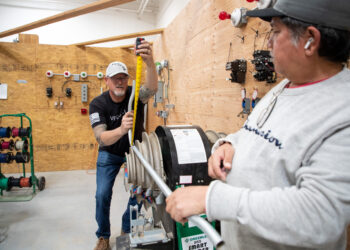
Culinary careers are sizzling again as the hospitality and restaurant industry bounces back from the pandemic and seeks to fill the positions vacated during the COVID-19 downturn. Chaffey College is doing its part to get more cooks in the kitchen.

While doctors and nurses hold the line against COVID-19 with their heroism, another equally essential – if little known – group of frontline workers have been bustling behind the scenes.
Community Health Workers (CHWs) champion underserved communities by providing a range of health and social services close to home. According to a recent CDC report, these professonals have been critical in helping close service gaps for those hardest hit during the pandemic.
The call for trained CHWs is undeniable… and Victor Valley College’s timing is impeccable. In response to unprecedented need, the College is launching a brand-new apprenticeship program aimed at placing these key workers into in-demand careers. For prospective health care workers, it’s a chance to graduate college with real-world training under their belts… and money in their pockets.
“Just a couple of days ago, the state approved our CHW program to be a registered apprenticeship,” beams Frank Castanos, Director of Community/Contract Ed. & Workforce Programs at VVC.
The program was piloted earlier this semester with incumbent worker training. Now, with state approval from the Division of Apprenticeship Standards (DAS), CHW courses are set to open to the public.
Facing increasing demand from regional employers, including hospitals and non-profits, the College worked with industry partner and community resource center Reach Out to promote employer engagement and develop a curriculum. The result was a bold plan to deliver workforce-urgent instruction in service coordination, advocacy and organizational training.
“This really was a collaborative effort,” shares Dr. Yara William, CHW instructor and Director of Health Workforce at Reach Out. William was instrumental in getting the program off the ground, with her doctorate research regarding CHWs setting a foundation for the apprenticeship. Since then, she has worked closely with professionals in the industry to prepare the program for launch.
“Once we identified a workforce need and the career growth opportunities, it was a matter of linking education with industry,” says William, whose passion is to promote the occupation within the health workforce.
According to the instructor, CHW skills lead to many health and human services career paths. Jobs include health coach, community health adviser, family advocate and outreach worker – all facing urgent demand in today’s workforce climate. Students in the program learn how to serve community needs, bolstering opportunities for those pursuing a helping profession with a healthy paycheck.
Industry partners offering real-world training opportunities include St. Joseph Health, Providence Health St. Mary Medical Center, Moses House Ministries, Mom & Dad Project, Valley Stars Behavioral Group, and Reach Out.
“There is a need across our region,” says Lilia Aguirre, Coordinator of Special Grants & Workforce Programs at Victor Valley College. “We started our program here specifically because our employers voiced that need.”
Indeed, statewide, the profession is booming at 12 percent, much faster than average, according to the U.S. Bureau of Labor Statistics. California ranks second in the nation in employment opportunities for this occupation, with workers commanding a healthy $45,280 on average.
CHWs often serve as a bridge between underserved communities and health care information and services. Meanwhile, they play a pivotal role in cultivating more culturally sensitive and accessible systems.
“The skills acquired through this apprenticeship program help address many of the socioeconomic barriers that our hard-to-reach populations experience,” says William.
For the instructor, the CHW profession is all about compassion in action: “It is the lived experiences, the heart, and deep understanding of the community that make CHWs successful and allow them to help their clients achieve a higher quality of life.”
From helping individuals access health insurance and overcome food insecurity to advocating for local health needs and providing interpretation services, CHWs are trusted community servants. On a typical day, their job duties might entail providing health screenings, assisting those completing benefit applications, performing home visits, and offering transportation to medical appointments.
In fact, according to a recent Policy Evidence Assessment Report from the National Center for Chronic Disease Prevention and Health Promotion, preventative care and social support like this have had a marked effect on health care costs. By addressing problems before they become emergencies, CHWs are saving more than just lives.
With workforce and community demand hitting new highs during the current health crisis, it’s more critical than ever to launch new training programs. And while colleges across the country are increasingly offering CHW courses, it’s “not necessarily as an apprenticeship,” explains Castanos. That, says the director, is why “we’re really excited to get this going.”
Apprentices will enjoy tuition-free courses while participating in paid, on-the-job training. So, not only will learners complete the program debt-free, but they’ll also build financial stability, along with connections to land their first careers.
The CHW apprenticeship is the latest addition to Local Apprenticeships Uniting a Network of Colleges & High Schools (LAUNCH), a project formed by the Inland Empire/Desert Regional Consortium in 2018. The project makes apprenticeships easy and effective for regional businesses and career-builders, linking the region’s community colleges, K-12 districts and workforce development boards.
“They are our guide through this,” Aguirre says about LAUNCH. “What we do is support each other to build innovative apprenticeships.”
The team approach has paid off, thanks to the hard work of stakeholders like Charles Henkels, Interim Director of Regional Apprenticeship and Work-Based Learning at Riverside Community College District, who was fundamental in getting the apprenticeship approved. Now, students can glean both theory and hands-on practice while progressing on proven professional development pathways.
The program is perfect for partnering businesses as well. Not only can companies develop a more robust talent pipeline, but registered apprenticeship programs may also qualify them for valuable tax credits. According to the DAS website, apprenticeships create efficient and cost-effective training systems while reducing the costs of high labor turnover. California currently has more than 93,000 apprentices across a variety of occupations, finding direct paths to gainful employment while strengthening the broader workforce.
“The employers that we are working with…seem very satisfied and happy,” says Castanos. “It’s meeting their needs, and they also see a lot of opportunities for this program to help the workforce, as well as the community as a whole.”
Apprentices will train as front office medical assistants, parent liaisons, care coordinators, health educators and more. Students who complete the apprenticeship program will receive a certificate recognized by DAS, and the College is currently working on obtaining state-level approval through the Chancellor’s office.
The training represents a bold paradigm shift for the College, as currently, the practice lacks fixed definitions and guidelines in the United States.
“There has been a rising need for formalizing it more than it has been so far,” explains Aguirre, who says that while many states are working on standardizing the profession, VVC is on the frontier in California.
According to the coordinator, “The apprenticeship is a really good way for us to put a stamp behind this career pathway.”
Kevin Mahany, Director of Community Health Investment at Providence Health St. Mary Medical Center, couldn’t agree mor“St. Mary applauds VVC for offering the High Desert education in Community Health Workers,” says the industry partner, who will soon welcome CHW apprentices into the ranks. “Our staff are honing their skills, and we look forward to future offerings.”
Sources:
Policy Evidence Assessment Report from the National Center for Chronic Disease Prevention and Health Promotion, CDC, https://www.cdc.gov/dhdsp/pubs/docs/chw_evidence_assessment_report.pdf
Engaging Community Health Workers to Support Home-based care for people with COVID-19 in low-resource settings, CDC, https://www.cdc.gov/coronavirus/2019-ncov/global-covid-19/home-based-care.html
Summary Report for Community Health Workers, O*NET Online, https://www.onetonline.org/link/summary/21-1094.00
Occupational Employment Statistics, Community Health Workers, U.S. Bureau of Labor Statistics, https://www.bls.gov/oes/current/oes211094.htm
State of California Division of Apprenticeship Standards, https://www.dir.ca.gov/DAS

Culinary careers are sizzling again as the hospitality and restaurant industry bounces back from the pandemic and seeks to fill the positions vacated during the COVID-19 downturn. Chaffey College is doing its part to get more cooks in the kitchen.

Dual Enrollment (DE) is catching on as students and their families recognize the advantages of earning college credit while still working towards high school graduation. But students aren’t the only… Read More – Good News for Community Colleges: Dual Enrollments Are on the Rise

Enrollment in courses not offering credit toward a degree or certificate are outpacing for-credit programs in some states (Fed Communities). And it’s no wonder. With the convenience, minimal time commitment,… Read More – No Credit, No Problem: Noncredit Courses Gain Steam